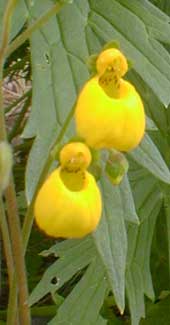
Falkland Pocketbook or Slipper Flower;
aka, Sand Lady-slipper, Topa-Topa,
Capachito or Capachito-topa
"Tiptoed many a slipper
To Paradise away."
-Emily Dickinson
(1830-1886)
(1830-1886)
Calceolaria falklandica is native not only of the Falklands but also from the Andes Mountains of Chile to Patagonia. The genus name means "small shoe."
In South America it is well known as Zapatito de la Virgin, or Sapatinho-de-virgem, The Virgin's Shoes, Englished as Capachito Flower.
It is by no means the only flower named for the Virgin Mary's footware. The common European monkshood (Aconitum nepallus) has in France been called "pantoufes de Marie" (Mary's Slippers). Bird's-foot trefoil (Lotus corniculatus) has been variously likened "Sabots de la Marie," "Sabots de Notre Dame," or "Sabots de la Vierge," all refering to Mary's boots, shoes, or clogs. Damascenicum nothum has gone by the name "Sanctum Mariae Calceolus" or Holy Mary's Shoes, which is also the meaning of Sanctum Marie Claues given to Cariophyl lata. Clovers (Melilotus spp) have similarly been called "Sanctum Mariae Calceoli" & Columbines have been known as Lady's Shoes. Balsam (lmpatiens balsamina or capensis) & ladyslippers or moccasin flowers of the Cypripedium genus, which greatly resemble Calceolaria slipperworts, have likewise been identified as shoes for the Virgin Mary.
This desire to identify a flower as the Virgin's footwear stems from a medieval folktale that asserts the Virgin in her greatest hours of need was always cared for, she & her babe, by things of the plantworld. All of her garments were made of flowers, from hat to corset to shoelaces, & all of flowery garments are kept fresh in a Virgin's Bower which is her arbored bedchamber of Clematis.
In Patagonia the only possible choice of flower was Calceolaria to fulfil this role. It was doubly identifiable because it has red speckles inside, which are said to be from the blood that spattered on the Virgin's feet as she held vigil beneath the Cross.
Basal leaves are usually under four inches tall, with the slipper flowers rising on on wiry stems to ten inches (its cultivar 'Goldcap' is usually shorter but otherwise indistinguishable). It begins flowering in May & with periodic deadheading will rebloom long into summer, occasionally into autumn.
It does not like ever to experience complete dryness, or too much sun exposure, & in its growing seasons especially it will withstand boggy conditions much more easily than it will tolerate summer heatwaves, & it cannot abide outright drought.
Although it is very cold-hardy, it is not tolerant of winter dampness, & in our gardens usually rots out of the garden during dormancy, hence must be planted with no greater expectation than one would have from annuals, though the occasional plant will return a second year. If there is a method by which to get it to more reliably perennialize in our zone, I haven't yet figured it out, but I keep trying because I'm so fond of seeing it in bloom.
The right balance of sharp winter drainage & perpetual spring & summer moisture is tricky, rendering the species tender in most temperate gardens. But even if it dies out of the garden after a year or two, it will bloom spectacularly in the meantime. In theory it can perennialize & spread, so that the short basal leaves form a groundcover, requiring spring or autumn division perhaps every four years if you get luckier than I've been.
It is said to be the hardiest of any of the generally tender pocketbook flowers, though in our garden C. integrifolia 'Kentish Hero' has done much better at perennializing with a larger clump each year.